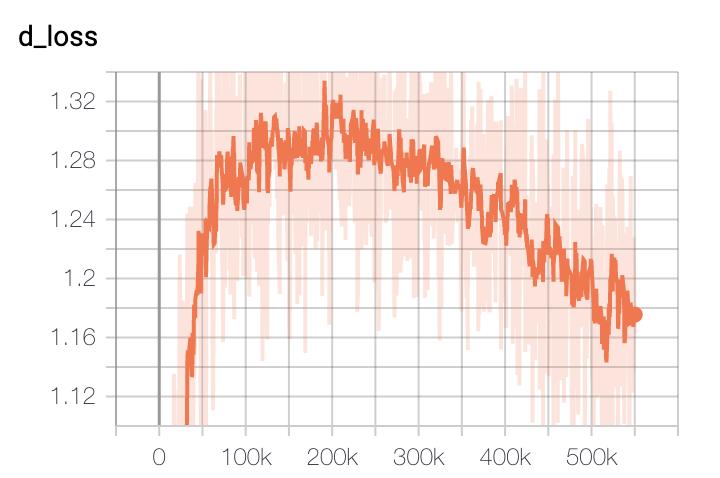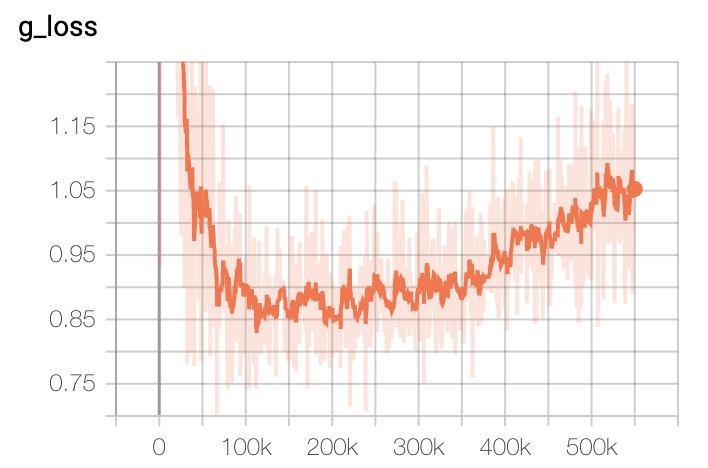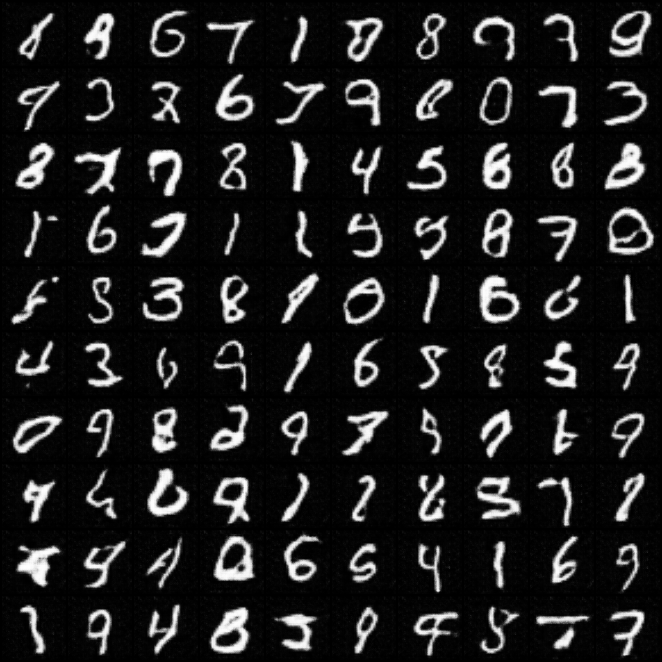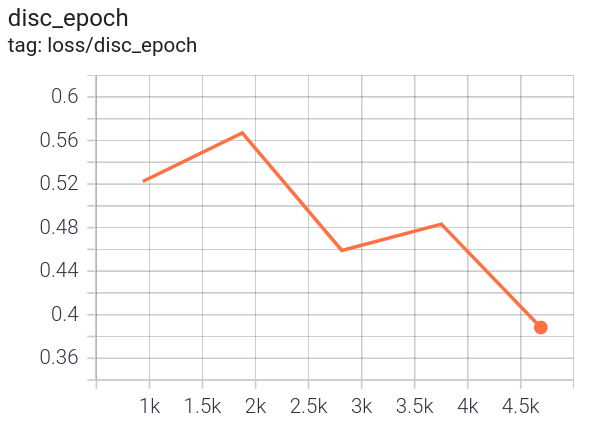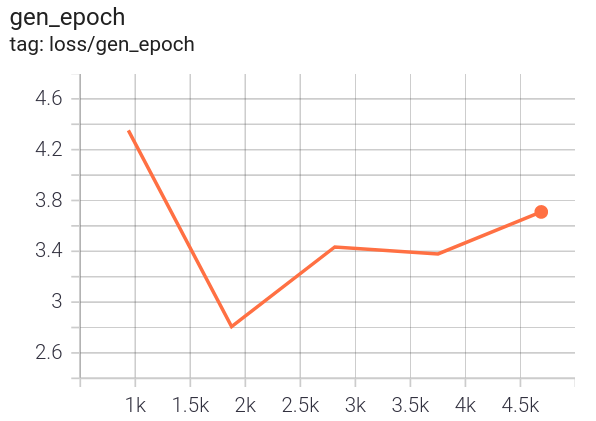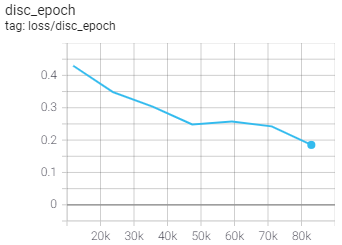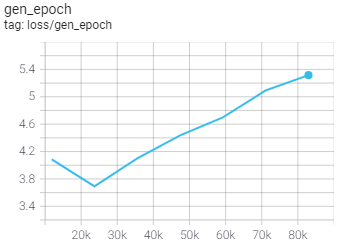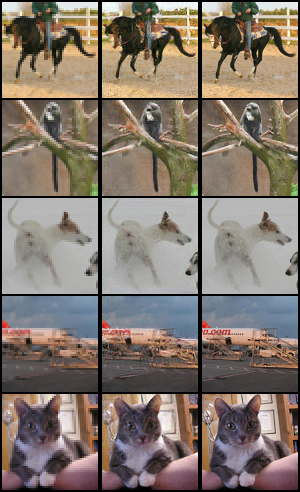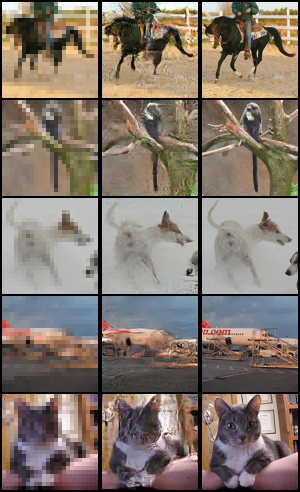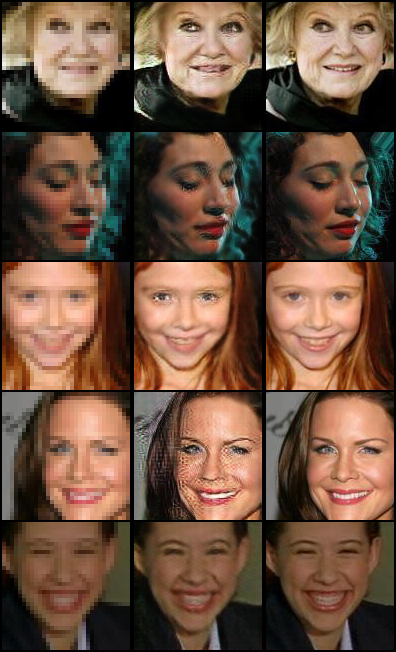GANs¶
Collection of Generative Adversarial Networks
Note
We rely on the community to keep these updated and working. If something doesn’t work, we’d really appreciate a contribution to fix!
Basic GAN¶
This is a vanilla GAN. This model can work on any dataset size but results are shown for MNIST. Replace the encoder, decoder or any part of the training loop to build a new method, or simply finetune on your data.
Implemented by:
William Falcon
Example outputs:
Loss curves:
from pl_bolts.models.gans import GAN
...
gan = GAN()
trainer = Trainer()
trainer.fit(gan)
- class pl_bolts.models.gans.GAN(input_channels, input_height, input_width, latent_dim=32, learning_rate=0.0002, **kwargs)[source]
Bases:
pytorch_lightning.core.module.LightningModuleVanilla GAN implementation.
Example:
from pl_bolts.models.gans import GAN m = GAN() Trainer(gpus=2).fit(m)
Example CLI:
# mnist python basic_gan_module.py --gpus 1 # imagenet python basic_gan_module.py --gpus 1 --dataset 'imagenet2012' --data_dir /path/to/imagenet/folder/ --meta_dir ~/path/to/meta/bin/folder --batch_size 256 --learning_rate 0.0001
- Parameters
- configure_optimizers()[source]
Choose what optimizers and learning-rate schedulers to use in your optimization. Normally you’d need one. But in the case of GANs or similar you might have multiple.
- Returns
Any of these 6 options.
Single optimizer.
List or Tuple of optimizers.
Two lists - The first list has multiple optimizers, and the second has multiple LR schedulers (or multiple
lr_scheduler_config).Dictionary, with an
"optimizer"key, and (optionally) a"lr_scheduler"key whose value is a single LR scheduler orlr_scheduler_config.Tuple of dictionaries as described above, with an optional
"frequency"key.None - Fit will run without any optimizer.
The
lr_scheduler_configis a dictionary which contains the scheduler and its associated configuration. The default configuration is shown below.lr_scheduler_config = { # REQUIRED: The scheduler instance "scheduler": lr_scheduler, # The unit of the scheduler's step size, could also be 'step'. # 'epoch' updates the scheduler on epoch end whereas 'step' # updates it after a optimizer update. "interval": "epoch", # How many epochs/steps should pass between calls to # `scheduler.step()`. 1 corresponds to updating the learning # rate after every epoch/step. "frequency": 1, # Metric to to monitor for schedulers like `ReduceLROnPlateau` "monitor": "val_loss", # If set to `True`, will enforce that the value specified 'monitor' # is available when the scheduler is updated, thus stopping # training if not found. If set to `False`, it will only produce a warning "strict": True, # If using the `LearningRateMonitor` callback to monitor the # learning rate progress, this keyword can be used to specify # a custom logged name "name": None, }
When there are schedulers in which the
.step()method is conditioned on a value, such as thetorch.optim.lr_scheduler.ReduceLROnPlateauscheduler, Lightning requires that thelr_scheduler_configcontains the keyword"monitor"set to the metric name that the scheduler should be conditioned on.# The ReduceLROnPlateau scheduler requires a monitor def configure_optimizers(self): optimizer = Adam(...) return { "optimizer": optimizer, "lr_scheduler": { "scheduler": ReduceLROnPlateau(optimizer, ...), "monitor": "metric_to_track", "frequency": "indicates how often the metric is updated" # If "monitor" references validation metrics, then "frequency" should be set to a # multiple of "trainer.check_val_every_n_epoch". }, } # In the case of two optimizers, only one using the ReduceLROnPlateau scheduler def configure_optimizers(self): optimizer1 = Adam(...) optimizer2 = SGD(...) scheduler1 = ReduceLROnPlateau(optimizer1, ...) scheduler2 = LambdaLR(optimizer2, ...) return ( { "optimizer": optimizer1, "lr_scheduler": { "scheduler": scheduler1, "monitor": "metric_to_track", }, }, {"optimizer": optimizer2, "lr_scheduler": scheduler2}, )
Metrics can be made available to monitor by simply logging it using
self.log('metric_to_track', metric_val)in yourLightningModule.Note
The
frequencyvalue specified in a dict along with theoptimizerkey is an int corresponding to the number of sequential batches optimized with the specific optimizer. It should be given to none or to all of the optimizers. There is a difference between passing multiple optimizers in a list, and passing multiple optimizers in dictionaries with a frequency of 1:In the former case, all optimizers will operate on the given batch in each optimization step.
In the latter, only one optimizer will operate on the given batch at every step.
This is different from the
frequencyvalue specified in thelr_scheduler_configmentioned above.def configure_optimizers(self): optimizer_one = torch.optim.SGD(self.model.parameters(), lr=0.01) optimizer_two = torch.optim.SGD(self.model.parameters(), lr=0.01) return [ {"optimizer": optimizer_one, "frequency": 5}, {"optimizer": optimizer_two, "frequency": 10}, ]
In this example, the first optimizer will be used for the first 5 steps, the second optimizer for the next 10 steps and that cycle will continue. If an LR scheduler is specified for an optimizer using the
lr_schedulerkey in the above dict, the scheduler will only be updated when its optimizer is being used.Examples:
# most cases. no learning rate scheduler def configure_optimizers(self): return Adam(self.parameters(), lr=1e-3) # multiple optimizer case (e.g.: GAN) def configure_optimizers(self): gen_opt = Adam(self.model_gen.parameters(), lr=0.01) dis_opt = Adam(self.model_dis.parameters(), lr=0.02) return gen_opt, dis_opt # example with learning rate schedulers def configure_optimizers(self): gen_opt = Adam(self.model_gen.parameters(), lr=0.01) dis_opt = Adam(self.model_dis.parameters(), lr=0.02) dis_sch = CosineAnnealing(dis_opt, T_max=10) return [gen_opt, dis_opt], [dis_sch] # example with step-based learning rate schedulers # each optimizer has its own scheduler def configure_optimizers(self): gen_opt = Adam(self.model_gen.parameters(), lr=0.01) dis_opt = Adam(self.model_dis.parameters(), lr=0.02) gen_sch = { 'scheduler': ExponentialLR(gen_opt, 0.99), 'interval': 'step' # called after each training step } dis_sch = CosineAnnealing(dis_opt, T_max=10) # called every epoch return [gen_opt, dis_opt], [gen_sch, dis_sch] # example with optimizer frequencies # see training procedure in `Improved Training of Wasserstein GANs`, Algorithm 1 # https://arxiv.org/abs/1704.00028 def configure_optimizers(self): gen_opt = Adam(self.model_gen.parameters(), lr=0.01) dis_opt = Adam(self.model_dis.parameters(), lr=0.02) n_critic = 5 return ( {'optimizer': dis_opt, 'frequency': n_critic}, {'optimizer': gen_opt, 'frequency': 1} )
Note
Some things to know:
Lightning calls
.backward()and.step()on each optimizer as needed.If learning rate scheduler is specified in
configure_optimizers()with key"interval"(default “epoch”) in the scheduler configuration, Lightning will call the scheduler’s.step()method automatically in case of automatic optimization.If you use 16-bit precision (
precision=16), Lightning will automatically handle the optimizers.If you use multiple optimizers,
training_step()will have an additionaloptimizer_idxparameter.If you use
torch.optim.LBFGS, Lightning handles the closure function automatically for you.If you use multiple optimizers, gradients will be calculated only for the parameters of current optimizer at each training step.
If you need to control how often those optimizers step or override the default
.step()schedule, override theoptimizer_step()hook.
- forward(z)[source]
Generates an image given input noise z.
Example:
z = torch.rand(batch_size, latent_dim) gan = GAN.load_from_checkpoint(PATH) img = gan(z)
- training_step(batch, batch_idx, optimizer_idx)[source]
Here you compute and return the training loss and some additional metrics for e.g. the progress bar or logger.
- Parameters
batch¶ (
Tensor| (Tensor, …) | [Tensor, …]) – The output of yourDataLoader. A tensor, tuple or list.batch_idx¶ (
int) – Integer displaying index of this batchoptimizer_idx¶ (
int) – When using multiple optimizers, this argument will also be present.hiddens¶ (
Any) – Passed in iftruncated_bptt_steps> 0.
- Returns
Any of.
Tensor- The loss tensordict- A dictionary. Can include any keys, but must include the key'loss'None- Training will skip to the next batch. This is only for automatic optimization.This is not supported for multi-GPU, TPU, IPU, or DeepSpeed.
In this step you’d normally do the forward pass and calculate the loss for a batch. You can also do fancier things like multiple forward passes or something model specific.
Example:
def training_step(self, batch, batch_idx): x, y, z = batch out = self.encoder(x) loss = self.loss(out, x) return loss
If you define multiple optimizers, this step will be called with an additional
optimizer_idxparameter.# Multiple optimizers (e.g.: GANs) def training_step(self, batch, batch_idx, optimizer_idx): if optimizer_idx == 0: # do training_step with encoder ... if optimizer_idx == 1: # do training_step with decoder ...
If you add truncated back propagation through time you will also get an additional argument with the hidden states of the previous step.
# Truncated back-propagation through time def training_step(self, batch, batch_idx, hiddens): # hiddens are the hidden states from the previous truncated backprop step out, hiddens = self.lstm(data, hiddens) loss = ... return {"loss": loss, "hiddens": hiddens}
Note
The loss value shown in the progress bar is smoothed (averaged) over the last values, so it differs from the actual loss returned in train/validation step.
DCGAN¶
DCGAN implementation from the paper Unsupervised Representation Learning with Deep Convolutional Generative Adversarial Networks. The implementation is based on the version from PyTorch’s examples.
Implemented by:
Example MNIST outputs:
Example LSUN bedroom outputs:
MNIST Loss curves:
LSUN Loss curves:
- class pl_bolts.models.gans.DCGAN(beta1=0.5, feature_maps_gen=64, feature_maps_disc=64, image_channels=1, latent_dim=100, learning_rate=0.0002, **kwargs)[source]
Bases:
pytorch_lightning.core.module.LightningModuleDCGAN implementation.
Example:
from pl_bolts.models.gans import DCGAN m = DCGAN() Trainer(accelerator="gpu", devices=2).fit(m)
Example CLI:
# mnist python dcgan_module.py --gpus 1 # cifar10 python dcgan_module.py --gpus 1 --dataset cifar10 --image_channels 3
- Parameters
- configure_optimizers()[source]
Choose what optimizers and learning-rate schedulers to use in your optimization. Normally you’d need one. But in the case of GANs or similar you might have multiple.
- Returns
Any of these 6 options.
Single optimizer.
List or Tuple of optimizers.
Two lists - The first list has multiple optimizers, and the second has multiple LR schedulers (or multiple
lr_scheduler_config).Dictionary, with an
"optimizer"key, and (optionally) a"lr_scheduler"key whose value is a single LR scheduler orlr_scheduler_config.Tuple of dictionaries as described above, with an optional
"frequency"key.None - Fit will run without any optimizer.
The
lr_scheduler_configis a dictionary which contains the scheduler and its associated configuration. The default configuration is shown below.lr_scheduler_config = { # REQUIRED: The scheduler instance "scheduler": lr_scheduler, # The unit of the scheduler's step size, could also be 'step'. # 'epoch' updates the scheduler on epoch end whereas 'step' # updates it after a optimizer update. "interval": "epoch", # How many epochs/steps should pass between calls to # `scheduler.step()`. 1 corresponds to updating the learning # rate after every epoch/step. "frequency": 1, # Metric to to monitor for schedulers like `ReduceLROnPlateau` "monitor": "val_loss", # If set to `True`, will enforce that the value specified 'monitor' # is available when the scheduler is updated, thus stopping # training if not found. If set to `False`, it will only produce a warning "strict": True, # If using the `LearningRateMonitor` callback to monitor the # learning rate progress, this keyword can be used to specify # a custom logged name "name": None, }
When there are schedulers in which the
.step()method is conditioned on a value, such as thetorch.optim.lr_scheduler.ReduceLROnPlateauscheduler, Lightning requires that thelr_scheduler_configcontains the keyword"monitor"set to the metric name that the scheduler should be conditioned on.# The ReduceLROnPlateau scheduler requires a monitor def configure_optimizers(self): optimizer = Adam(...) return { "optimizer": optimizer, "lr_scheduler": { "scheduler": ReduceLROnPlateau(optimizer, ...), "monitor": "metric_to_track", "frequency": "indicates how often the metric is updated" # If "monitor" references validation metrics, then "frequency" should be set to a # multiple of "trainer.check_val_every_n_epoch". }, } # In the case of two optimizers, only one using the ReduceLROnPlateau scheduler def configure_optimizers(self): optimizer1 = Adam(...) optimizer2 = SGD(...) scheduler1 = ReduceLROnPlateau(optimizer1, ...) scheduler2 = LambdaLR(optimizer2, ...) return ( { "optimizer": optimizer1, "lr_scheduler": { "scheduler": scheduler1, "monitor": "metric_to_track", }, }, {"optimizer": optimizer2, "lr_scheduler": scheduler2}, )
Metrics can be made available to monitor by simply logging it using
self.log('metric_to_track', metric_val)in yourLightningModule.Note
The
frequencyvalue specified in a dict along with theoptimizerkey is an int corresponding to the number of sequential batches optimized with the specific optimizer. It should be given to none or to all of the optimizers. There is a difference between passing multiple optimizers in a list, and passing multiple optimizers in dictionaries with a frequency of 1:In the former case, all optimizers will operate on the given batch in each optimization step.
In the latter, only one optimizer will operate on the given batch at every step.
This is different from the
frequencyvalue specified in thelr_scheduler_configmentioned above.def configure_optimizers(self): optimizer_one = torch.optim.SGD(self.model.parameters(), lr=0.01) optimizer_two = torch.optim.SGD(self.model.parameters(), lr=0.01) return [ {"optimizer": optimizer_one, "frequency": 5}, {"optimizer": optimizer_two, "frequency": 10}, ]
In this example, the first optimizer will be used for the first 5 steps, the second optimizer for the next 10 steps and that cycle will continue. If an LR scheduler is specified for an optimizer using the
lr_schedulerkey in the above dict, the scheduler will only be updated when its optimizer is being used.Examples:
# most cases. no learning rate scheduler def configure_optimizers(self): return Adam(self.parameters(), lr=1e-3) # multiple optimizer case (e.g.: GAN) def configure_optimizers(self): gen_opt = Adam(self.model_gen.parameters(), lr=0.01) dis_opt = Adam(self.model_dis.parameters(), lr=0.02) return gen_opt, dis_opt # example with learning rate schedulers def configure_optimizers(self): gen_opt = Adam(self.model_gen.parameters(), lr=0.01) dis_opt = Adam(self.model_dis.parameters(), lr=0.02) dis_sch = CosineAnnealing(dis_opt, T_max=10) return [gen_opt, dis_opt], [dis_sch] # example with step-based learning rate schedulers # each optimizer has its own scheduler def configure_optimizers(self): gen_opt = Adam(self.model_gen.parameters(), lr=0.01) dis_opt = Adam(self.model_dis.parameters(), lr=0.02) gen_sch = { 'scheduler': ExponentialLR(gen_opt, 0.99), 'interval': 'step' # called after each training step } dis_sch = CosineAnnealing(dis_opt, T_max=10) # called every epoch return [gen_opt, dis_opt], [gen_sch, dis_sch] # example with optimizer frequencies # see training procedure in `Improved Training of Wasserstein GANs`, Algorithm 1 # https://arxiv.org/abs/1704.00028 def configure_optimizers(self): gen_opt = Adam(self.model_gen.parameters(), lr=0.01) dis_opt = Adam(self.model_dis.parameters(), lr=0.02) n_critic = 5 return ( {'optimizer': dis_opt, 'frequency': n_critic}, {'optimizer': gen_opt, 'frequency': 1} )
Note
Some things to know:
Lightning calls
.backward()and.step()on each optimizer as needed.If learning rate scheduler is specified in
configure_optimizers()with key"interval"(default “epoch”) in the scheduler configuration, Lightning will call the scheduler’s.step()method automatically in case of automatic optimization.If you use 16-bit precision (
precision=16), Lightning will automatically handle the optimizers.If you use multiple optimizers,
training_step()will have an additionaloptimizer_idxparameter.If you use
torch.optim.LBFGS, Lightning handles the closure function automatically for you.If you use multiple optimizers, gradients will be calculated only for the parameters of current optimizer at each training step.
If you need to control how often those optimizers step or override the default
.step()schedule, override theoptimizer_step()hook.
- forward(noise)[source]
Generates an image given input noise.
Example:
noise = torch.rand(batch_size, latent_dim) gan = GAN.load_from_checkpoint(PATH) img = gan(noise)
- Return type
- training_step(batch, batch_idx, optimizer_idx)[source]
Here you compute and return the training loss and some additional metrics for e.g. the progress bar or logger.
- Parameters
batch¶ (
Tensor| (Tensor, …) | [Tensor, …]) – The output of yourDataLoader. A tensor, tuple or list.batch_idx¶ (
int) – Integer displaying index of this batchoptimizer_idx¶ (
int) – When using multiple optimizers, this argument will also be present.hiddens¶ (
Any) – Passed in iftruncated_bptt_steps> 0.
- Returns
Any of.
Tensor- The loss tensordict- A dictionary. Can include any keys, but must include the key'loss'None- Training will skip to the next batch. This is only for automatic optimization.This is not supported for multi-GPU, TPU, IPU, or DeepSpeed.
In this step you’d normally do the forward pass and calculate the loss for a batch. You can also do fancier things like multiple forward passes or something model specific.
Example:
def training_step(self, batch, batch_idx): x, y, z = batch out = self.encoder(x) loss = self.loss(out, x) return loss
If you define multiple optimizers, this step will be called with an additional
optimizer_idxparameter.# Multiple optimizers (e.g.: GANs) def training_step(self, batch, batch_idx, optimizer_idx): if optimizer_idx == 0: # do training_step with encoder ... if optimizer_idx == 1: # do training_step with decoder ...
If you add truncated back propagation through time you will also get an additional argument with the hidden states of the previous step.
# Truncated back-propagation through time def training_step(self, batch, batch_idx, hiddens): # hiddens are the hidden states from the previous truncated backprop step out, hiddens = self.lstm(data, hiddens) loss = ... return {"loss": loss, "hiddens": hiddens}
Note
The loss value shown in the progress bar is smoothed (averaged) over the last values, so it differs from the actual loss returned in train/validation step.
SRGAN¶
SRGAN implementation from the paper Photo-Realistic Single Image Super-Resolution Using a Generative Adversarial Network. The implementation is based on the version from deeplearning.ai.
Implemented by:
MNIST results:
SRGAN MNIST with scale factor of 2 (left: low res, middle: generated high res, right: ground truth high res):
SRGAN MNIST with scale factor of 4:
- SRResNet pretraining command used::
- SRGAN training command used::
STL10 results:
SRGAN STL10 with scale factor of 2:
SRGAN STL10 with scale factor of 4:
- SRResNet pretraining command used::
- SRGAN training command used::
CelebA results:
SRGAN CelebA with scale factor of 2:
SRGAN CelebA with scale factor of 4:
- SRResNet pretraining command used::
- SRGAN training command used::
- class pl_bolts.models.gans.SRGAN(image_channels=3, feature_maps_gen=64, feature_maps_disc=64, num_res_blocks=16, scale_factor=4, generator_checkpoint=None, learning_rate=0.0001, scheduler_step=100, **kwargs)[source]
Bases:
pytorch_lightning.core.module.LightningModuleWarning
The feature SRGAN is currently marked under review. The compatibility with other Lightning projects is not guaranteed and API may change at any time. The API and functionality may change without warning in future releases. More details: https://lightning-bolts.readthedocs.io/en/latest/stability.html
SRGAN implementation from the paper Photo-Realistic Single Image Super-Resolution Using a Generative Adversarial Network. It uses a pretrained SRResNet model as the generator if available.
Code adapted from https-deeplearning-ai/GANs-Public to Lightning by:
You can pretrain a SRResNet model with
srresnet_module.py.Example:
from pl_bolts.models.gan import SRGAN m = SRGAN() Trainer(gpus=1).fit(m)
Example CLI:
# CelebA dataset, scale_factor 4 python srgan_module.py --dataset=celeba --scale_factor=4 --gpus=1 # MNIST dataset, scale_factor 4 python srgan_module.py --dataset=mnist --scale_factor=4 --gpus=1 # STL10 dataset, scale_factor 4 python srgan_module.py --dataset=stl10 --scale_factor=4 --gpus=1
- Parameters
image_channels¶ (
int) – Number of channels of the images from the datasetfeature_maps_gen¶ (
int) – Number of feature maps to use for the generatorfeature_maps_disc¶ (
int) – Number of feature maps to use for the discriminatornum_res_blocks¶ (
int) – Number of res blocks to use in the generatorscale_factor¶ (
int) – Scale factor for the images (either 2 or 4)generator_checkpoint¶ (
Optional[str]) – Generator checkpoint created with SRResNet modulescheduler_step¶ (
int) – Number of epochs after which the learning rate gets decayed
- configure_optimizers()[source]
Choose what optimizers and learning-rate schedulers to use in your optimization. Normally you’d need one. But in the case of GANs or similar you might have multiple.
- Return type
Tuple[List[Adam],List[MultiStepLR]]- Returns
Any of these 6 options.
Single optimizer.
List or Tuple of optimizers.
Two lists - The first list has multiple optimizers, and the second has multiple LR schedulers (or multiple
lr_scheduler_config).Dictionary, with an
"optimizer"key, and (optionally) a"lr_scheduler"key whose value is a single LR scheduler orlr_scheduler_config.Tuple of dictionaries as described above, with an optional
"frequency"key.None - Fit will run without any optimizer.
The
lr_scheduler_configis a dictionary which contains the scheduler and its associated configuration. The default configuration is shown below.lr_scheduler_config = { # REQUIRED: The scheduler instance "scheduler": lr_scheduler, # The unit of the scheduler's step size, could also be 'step'. # 'epoch' updates the scheduler on epoch end whereas 'step' # updates it after a optimizer update. "interval": "epoch", # How many epochs/steps should pass between calls to # `scheduler.step()`. 1 corresponds to updating the learning # rate after every epoch/step. "frequency": 1, # Metric to to monitor for schedulers like `ReduceLROnPlateau` "monitor": "val_loss", # If set to `True`, will enforce that the value specified 'monitor' # is available when the scheduler is updated, thus stopping # training if not found. If set to `False`, it will only produce a warning "strict": True, # If using the `LearningRateMonitor` callback to monitor the # learning rate progress, this keyword can be used to specify # a custom logged name "name": None, }
When there are schedulers in which the
.step()method is conditioned on a value, such as thetorch.optim.lr_scheduler.ReduceLROnPlateauscheduler, Lightning requires that thelr_scheduler_configcontains the keyword"monitor"set to the metric name that the scheduler should be conditioned on.# The ReduceLROnPlateau scheduler requires a monitor def configure_optimizers(self): optimizer = Adam(...) return { "optimizer": optimizer, "lr_scheduler": { "scheduler": ReduceLROnPlateau(optimizer, ...), "monitor": "metric_to_track", "frequency": "indicates how often the metric is updated" # If "monitor" references validation metrics, then "frequency" should be set to a # multiple of "trainer.check_val_every_n_epoch". }, } # In the case of two optimizers, only one using the ReduceLROnPlateau scheduler def configure_optimizers(self): optimizer1 = Adam(...) optimizer2 = SGD(...) scheduler1 = ReduceLROnPlateau(optimizer1, ...) scheduler2 = LambdaLR(optimizer2, ...) return ( { "optimizer": optimizer1, "lr_scheduler": { "scheduler": scheduler1, "monitor": "metric_to_track", }, }, {"optimizer": optimizer2, "lr_scheduler": scheduler2}, )
Metrics can be made available to monitor by simply logging it using
self.log('metric_to_track', metric_val)in yourLightningModule.Note
The
frequencyvalue specified in a dict along with theoptimizerkey is an int corresponding to the number of sequential batches optimized with the specific optimizer. It should be given to none or to all of the optimizers. There is a difference between passing multiple optimizers in a list, and passing multiple optimizers in dictionaries with a frequency of 1:In the former case, all optimizers will operate on the given batch in each optimization step.
In the latter, only one optimizer will operate on the given batch at every step.
This is different from the
frequencyvalue specified in thelr_scheduler_configmentioned above.def configure_optimizers(self): optimizer_one = torch.optim.SGD(self.model.parameters(), lr=0.01) optimizer_two = torch.optim.SGD(self.model.parameters(), lr=0.01) return [ {"optimizer": optimizer_one, "frequency": 5}, {"optimizer": optimizer_two, "frequency": 10}, ]
In this example, the first optimizer will be used for the first 5 steps, the second optimizer for the next 10 steps and that cycle will continue. If an LR scheduler is specified for an optimizer using the
lr_schedulerkey in the above dict, the scheduler will only be updated when its optimizer is being used.Examples:
# most cases. no learning rate scheduler def configure_optimizers(self): return Adam(self.parameters(), lr=1e-3) # multiple optimizer case (e.g.: GAN) def configure_optimizers(self): gen_opt = Adam(self.model_gen.parameters(), lr=0.01) dis_opt = Adam(self.model_dis.parameters(), lr=0.02) return gen_opt, dis_opt # example with learning rate schedulers def configure_optimizers(self): gen_opt = Adam(self.model_gen.parameters(), lr=0.01) dis_opt = Adam(self.model_dis.parameters(), lr=0.02) dis_sch = CosineAnnealing(dis_opt, T_max=10) return [gen_opt, dis_opt], [dis_sch] # example with step-based learning rate schedulers # each optimizer has its own scheduler def configure_optimizers(self): gen_opt = Adam(self.model_gen.parameters(), lr=0.01) dis_opt = Adam(self.model_dis.parameters(), lr=0.02) gen_sch = { 'scheduler': ExponentialLR(gen_opt, 0.99), 'interval': 'step' # called after each training step } dis_sch = CosineAnnealing(dis_opt, T_max=10) # called every epoch return [gen_opt, dis_opt], [gen_sch, dis_sch] # example with optimizer frequencies # see training procedure in `Improved Training of Wasserstein GANs`, Algorithm 1 # https://arxiv.org/abs/1704.00028 def configure_optimizers(self): gen_opt = Adam(self.model_gen.parameters(), lr=0.01) dis_opt = Adam(self.model_dis.parameters(), lr=0.02) n_critic = 5 return ( {'optimizer': dis_opt, 'frequency': n_critic}, {'optimizer': gen_opt, 'frequency': 1} )
Note
Some things to know:
Lightning calls
.backward()and.step()on each optimizer as needed.If learning rate scheduler is specified in
configure_optimizers()with key"interval"(default “epoch”) in the scheduler configuration, Lightning will call the scheduler’s.step()method automatically in case of automatic optimization.If you use 16-bit precision (
precision=16), Lightning will automatically handle the optimizers.If you use multiple optimizers,
training_step()will have an additionaloptimizer_idxparameter.If you use
torch.optim.LBFGS, Lightning handles the closure function automatically for you.If you use multiple optimizers, gradients will be calculated only for the parameters of current optimizer at each training step.
If you need to control how often those optimizers step or override the default
.step()schedule, override theoptimizer_step()hook.
- forward(lr_image)[source]
Generates a high resolution image given a low resolution image.
Example:
srgan = SRGAN.load_from_checkpoint(PATH) hr_image = srgan(lr_image)
- Return type
- training_step(batch, batch_idx, optimizer_idx)[source]
Here you compute and return the training loss and some additional metrics for e.g. the progress bar or logger.
- Parameters
batch¶ (
Tensor| (Tensor, …) | [Tensor, …]) – The output of yourDataLoader. A tensor, tuple or list.batch_idx¶ (
int) – Integer displaying index of this batchoptimizer_idx¶ (
int) – When using multiple optimizers, this argument will also be present.hiddens¶ (
Any) – Passed in iftruncated_bptt_steps> 0.
- Return type
- Returns
Any of.
Tensor- The loss tensordict- A dictionary. Can include any keys, but must include the key'loss'None- Training will skip to the next batch. This is only for automatic optimization.This is not supported for multi-GPU, TPU, IPU, or DeepSpeed.
In this step you’d normally do the forward pass and calculate the loss for a batch. You can also do fancier things like multiple forward passes or something model specific.
Example:
def training_step(self, batch, batch_idx): x, y, z = batch out = self.encoder(x) loss = self.loss(out, x) return loss
If you define multiple optimizers, this step will be called with an additional
optimizer_idxparameter.# Multiple optimizers (e.g.: GANs) def training_step(self, batch, batch_idx, optimizer_idx): if optimizer_idx == 0: # do training_step with encoder ... if optimizer_idx == 1: # do training_step with decoder ...
If you add truncated back propagation through time you will also get an additional argument with the hidden states of the previous step.
# Truncated back-propagation through time def training_step(self, batch, batch_idx, hiddens): # hiddens are the hidden states from the previous truncated backprop step out, hiddens = self.lstm(data, hiddens) loss = ... return {"loss": loss, "hiddens": hiddens}
Note
The loss value shown in the progress bar is smoothed (averaged) over the last values, so it differs from the actual loss returned in train/validation step.
- class pl_bolts.models.gans.SRResNet(image_channels=3, feature_maps=64, num_res_blocks=16, scale_factor=4, learning_rate=0.0001, **kwargs)[source]
Bases:
pytorch_lightning.core.module.LightningModuleWarning
The feature SRResNet is currently marked under review. The compatibility with other Lightning projects is not guaranteed and API may change at any time. The API and functionality may change without warning in future releases. More details: https://lightning-bolts.readthedocs.io/en/latest/stability.html
SRResNet implementation from the paper Photo-Realistic Single Image Super-Resolution Using a Generative Adversarial Network. A pretrained SRResNet model is used as the generator for SRGAN.
Code adapted from https-deeplearning-ai/GANs-Public to Lightning by:
Example:
from pl_bolts.models.gan import SRResNet m = SRResNet() Trainer(gpus=1).fit(m)
Example CLI:
# CelebA dataset, scale_factor 4 python srresnet_module.py --dataset=celeba --scale_factor=4 --gpus=1 # MNIST dataset, scale_factor 4 python srresnet_module.py --dataset=mnist --scale_factor=4 --gpus=1 # STL10 dataset, scale_factor 4 python srresnet_module.py --dataset=stl10 --scale_factor=4 --gpus=1
- Parameters
- configure_optimizers()[source]
Choose what optimizers and learning-rate schedulers to use in your optimization. Normally you’d need one. But in the case of GANs or similar you might have multiple.
- Return type
- Returns
Any of these 6 options.
Single optimizer.
List or Tuple of optimizers.
Two lists - The first list has multiple optimizers, and the second has multiple LR schedulers (or multiple
lr_scheduler_config).Dictionary, with an
"optimizer"key, and (optionally) a"lr_scheduler"key whose value is a single LR scheduler orlr_scheduler_config.Tuple of dictionaries as described above, with an optional
"frequency"key.None - Fit will run without any optimizer.
The
lr_scheduler_configis a dictionary which contains the scheduler and its associated configuration. The default configuration is shown below.lr_scheduler_config = { # REQUIRED: The scheduler instance "scheduler": lr_scheduler, # The unit of the scheduler's step size, could also be 'step'. # 'epoch' updates the scheduler on epoch end whereas 'step' # updates it after a optimizer update. "interval": "epoch", # How many epochs/steps should pass between calls to # `scheduler.step()`. 1 corresponds to updating the learning # rate after every epoch/step. "frequency": 1, # Metric to to monitor for schedulers like `ReduceLROnPlateau` "monitor": "val_loss", # If set to `True`, will enforce that the value specified 'monitor' # is available when the scheduler is updated, thus stopping # training if not found. If set to `False`, it will only produce a warning "strict": True, # If using the `LearningRateMonitor` callback to monitor the # learning rate progress, this keyword can be used to specify # a custom logged name "name": None, }
When there are schedulers in which the
.step()method is conditioned on a value, such as thetorch.optim.lr_scheduler.ReduceLROnPlateauscheduler, Lightning requires that thelr_scheduler_configcontains the keyword"monitor"set to the metric name that the scheduler should be conditioned on.# The ReduceLROnPlateau scheduler requires a monitor def configure_optimizers(self): optimizer = Adam(...) return { "optimizer": optimizer, "lr_scheduler": { "scheduler": ReduceLROnPlateau(optimizer, ...), "monitor": "metric_to_track", "frequency": "indicates how often the metric is updated" # If "monitor" references validation metrics, then "frequency" should be set to a # multiple of "trainer.check_val_every_n_epoch". }, } # In the case of two optimizers, only one using the ReduceLROnPlateau scheduler def configure_optimizers(self): optimizer1 = Adam(...) optimizer2 = SGD(...) scheduler1 = ReduceLROnPlateau(optimizer1, ...) scheduler2 = LambdaLR(optimizer2, ...) return ( { "optimizer": optimizer1, "lr_scheduler": { "scheduler": scheduler1, "monitor": "metric_to_track", }, }, {"optimizer": optimizer2, "lr_scheduler": scheduler2}, )
Metrics can be made available to monitor by simply logging it using
self.log('metric_to_track', metric_val)in yourLightningModule.Note
The
frequencyvalue specified in a dict along with theoptimizerkey is an int corresponding to the number of sequential batches optimized with the specific optimizer. It should be given to none or to all of the optimizers. There is a difference between passing multiple optimizers in a list, and passing multiple optimizers in dictionaries with a frequency of 1:In the former case, all optimizers will operate on the given batch in each optimization step.
In the latter, only one optimizer will operate on the given batch at every step.
This is different from the
frequencyvalue specified in thelr_scheduler_configmentioned above.def configure_optimizers(self): optimizer_one = torch.optim.SGD(self.model.parameters(), lr=0.01) optimizer_two = torch.optim.SGD(self.model.parameters(), lr=0.01) return [ {"optimizer": optimizer_one, "frequency": 5}, {"optimizer": optimizer_two, "frequency": 10}, ]
In this example, the first optimizer will be used for the first 5 steps, the second optimizer for the next 10 steps and that cycle will continue. If an LR scheduler is specified for an optimizer using the
lr_schedulerkey in the above dict, the scheduler will only be updated when its optimizer is being used.Examples:
# most cases. no learning rate scheduler def configure_optimizers(self): return Adam(self.parameters(), lr=1e-3) # multiple optimizer case (e.g.: GAN) def configure_optimizers(self): gen_opt = Adam(self.model_gen.parameters(), lr=0.01) dis_opt = Adam(self.model_dis.parameters(), lr=0.02) return gen_opt, dis_opt # example with learning rate schedulers def configure_optimizers(self): gen_opt = Adam(self.model_gen.parameters(), lr=0.01) dis_opt = Adam(self.model_dis.parameters(), lr=0.02) dis_sch = CosineAnnealing(dis_opt, T_max=10) return [gen_opt, dis_opt], [dis_sch] # example with step-based learning rate schedulers # each optimizer has its own scheduler def configure_optimizers(self): gen_opt = Adam(self.model_gen.parameters(), lr=0.01) dis_opt = Adam(self.model_dis.parameters(), lr=0.02) gen_sch = { 'scheduler': ExponentialLR(gen_opt, 0.99), 'interval': 'step' # called after each training step } dis_sch = CosineAnnealing(dis_opt, T_max=10) # called every epoch return [gen_opt, dis_opt], [gen_sch, dis_sch] # example with optimizer frequencies # see training procedure in `Improved Training of Wasserstein GANs`, Algorithm 1 # https://arxiv.org/abs/1704.00028 def configure_optimizers(self): gen_opt = Adam(self.model_gen.parameters(), lr=0.01) dis_opt = Adam(self.model_dis.parameters(), lr=0.02) n_critic = 5 return ( {'optimizer': dis_opt, 'frequency': n_critic}, {'optimizer': gen_opt, 'frequency': 1} )
Note
Some things to know:
Lightning calls
.backward()and.step()on each optimizer as needed.If learning rate scheduler is specified in
configure_optimizers()with key"interval"(default “epoch”) in the scheduler configuration, Lightning will call the scheduler’s.step()method automatically in case of automatic optimization.If you use 16-bit precision (
precision=16), Lightning will automatically handle the optimizers.If you use multiple optimizers,
training_step()will have an additionaloptimizer_idxparameter.If you use
torch.optim.LBFGS, Lightning handles the closure function automatically for you.If you use multiple optimizers, gradients will be calculated only for the parameters of current optimizer at each training step.
If you need to control how often those optimizers step or override the default
.step()schedule, override theoptimizer_step()hook.
- forward(lr_image)[source]
Creates a high resolution image given a low resolution image.
Example:
srresnet = SRResNet.load_from_checkpoint(PATH) hr_image = srresnet(lr_image)
- Return type
- test_step(batch, batch_idx)[source]
Operates on a single batch of data from the test set. In this step you’d normally generate examples or calculate anything of interest such as accuracy.
# the pseudocode for these calls test_outs = [] for test_batch in test_data: out = test_step(test_batch) test_outs.append(out) test_epoch_end(test_outs)
- Parameters
- Return type
- Returns
Any of.
Any object or value
None- Testing will skip to the next batch
# if you have one test dataloader: def test_step(self, batch, batch_idx): ... # if you have multiple test dataloaders: def test_step(self, batch, batch_idx, dataloader_idx=0): ...
Examples:
# CASE 1: A single test dataset def test_step(self, batch, batch_idx): x, y = batch # implement your own out = self(x) loss = self.loss(out, y) # log 6 example images # or generated text... or whatever sample_imgs = x[:6] grid = torchvision.utils.make_grid(sample_imgs) self.logger.experiment.add_image('example_images', grid, 0) # calculate acc labels_hat = torch.argmax(out, dim=1) test_acc = torch.sum(y == labels_hat).item() / (len(y) * 1.0) # log the outputs! self.log_dict({'test_loss': loss, 'test_acc': test_acc})
If you pass in multiple test dataloaders,
test_step()will have an additional argument. We recommend setting the default value of 0 so that you can quickly switch between single and multiple dataloaders.# CASE 2: multiple test dataloaders def test_step(self, batch, batch_idx, dataloader_idx=0): # dataloader_idx tells you which dataset this is. ...
Note
If you don’t need to test you don’t need to implement this method.
Note
When the
test_step()is called, the model has been put in eval mode and PyTorch gradients have been disabled. At the end of the test epoch, the model goes back to training mode and gradients are enabled.
- training_step(batch, batch_idx)[source]
Here you compute and return the training loss and some additional metrics for e.g. the progress bar or logger.
- Parameters
batch¶ (
Tensor| (Tensor, …) | [Tensor, …]) – The output of yourDataLoader. A tensor, tuple or list.batch_idx¶ (
int) – Integer displaying index of this batchoptimizer_idx¶ (
int) – When using multiple optimizers, this argument will also be present.hiddens¶ (
Any) – Passed in iftruncated_bptt_steps> 0.
- Return type
- Returns
Any of.
Tensor- The loss tensordict- A dictionary. Can include any keys, but must include the key'loss'None- Training will skip to the next batch. This is only for automatic optimization.This is not supported for multi-GPU, TPU, IPU, or DeepSpeed.
In this step you’d normally do the forward pass and calculate the loss for a batch. You can also do fancier things like multiple forward passes or something model specific.
Example:
def training_step(self, batch, batch_idx): x, y, z = batch out = self.encoder(x) loss = self.loss(out, x) return loss
If you define multiple optimizers, this step will be called with an additional
optimizer_idxparameter.# Multiple optimizers (e.g.: GANs) def training_step(self, batch, batch_idx, optimizer_idx): if optimizer_idx == 0: # do training_step with encoder ... if optimizer_idx == 1: # do training_step with decoder ...
If you add truncated back propagation through time you will also get an additional argument with the hidden states of the previous step.
# Truncated back-propagation through time def training_step(self, batch, batch_idx, hiddens): # hiddens are the hidden states from the previous truncated backprop step out, hiddens = self.lstm(data, hiddens) loss = ... return {"loss": loss, "hiddens": hiddens}
Note
The loss value shown in the progress bar is smoothed (averaged) over the last values, so it differs from the actual loss returned in train/validation step.
- validation_step(batch, batch_idx)[source]
Operates on a single batch of data from the validation set. In this step you’d might generate examples or calculate anything of interest like accuracy.
# the pseudocode for these calls val_outs = [] for val_batch in val_data: out = validation_step(val_batch) val_outs.append(out) validation_epoch_end(val_outs)
- Parameters
- Return type
- Returns
Any object or value
None- Validation will skip to the next batch
# pseudocode of order val_outs = [] for val_batch in val_data: out = validation_step(val_batch) if defined("validation_step_end"): out = validation_step_end(out) val_outs.append(out) val_outs = validation_epoch_end(val_outs)
# if you have one val dataloader: def validation_step(self, batch, batch_idx): ... # if you have multiple val dataloaders: def validation_step(self, batch, batch_idx, dataloader_idx=0): ...
Examples:
# CASE 1: A single validation dataset def validation_step(self, batch, batch_idx): x, y = batch # implement your own out = self(x) loss = self.loss(out, y) # log 6 example images # or generated text... or whatever sample_imgs = x[:6] grid = torchvision.utils.make_grid(sample_imgs) self.logger.experiment.add_image('example_images', grid, 0) # calculate acc labels_hat = torch.argmax(out, dim=1) val_acc = torch.sum(y == labels_hat).item() / (len(y) * 1.0) # log the outputs! self.log_dict({'val_loss': loss, 'val_acc': val_acc})
If you pass in multiple val dataloaders,
validation_step()will have an additional argument. We recommend setting the default value of 0 so that you can quickly switch between single and multiple dataloaders.# CASE 2: multiple validation dataloaders def validation_step(self, batch, batch_idx, dataloader_idx=0): # dataloader_idx tells you which dataset this is. ...
Note
If you don’t need to validate you don’t need to implement this method.
Note
When the
validation_step()is called, the model has been put in eval mode and PyTorch gradients have been disabled. At the end of validation, the model goes back to training mode and gradients are enabled.

